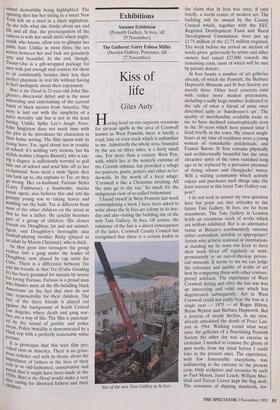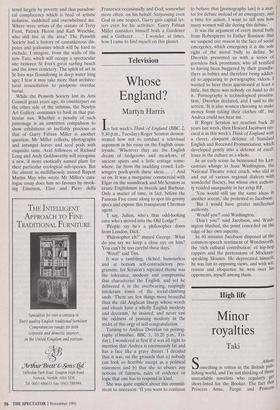Exhibitions
Autumn Exhibition (Penwith Gallery, St Ives, till 29 November) The Gatherer Garry Fabian Miller (Newlyn Gallery, Penzance, till 27 November)
Kiss of life
Giles Auty
Having lived on two separate occasions for six-year spells in the area of Cornwall known as West Penwith, there is hardly a road, lane or even track which is unfamiliar to me. Admittedly the whole area, bounded by the sea on three sides, is a fairly small one. For more than a century West Pen- with, which lies at the westerly extreme of the Cornish isthmus, has provided a refuge for painters, poets, potters and other ne'er- do-wells. In the words of a local adage: 'Cornwall is like a Christmas stocking. All the nuts go to the toe.' So much for the indigenous view of so-called bohemians.
I found myself in West Penwith last week contemplating a book I have been asked to write about the St Ives art colony in its hey- day and also visiting the building site of the new Tate Gallery, St Ives. Of course, the existence of the last is a direct consequence of the latter. Cornwall County Council has recognised that there is a certain kudos in Site of the new Tate Gallery at St Ives the claim that St Ives was once, if only briefly, a world centre of modern art. The building will be owned by the County Council which, together with the EEC Regional Development Fund and Rural Development Commission, have put up /1.75 million of the 12.75 million required. The week before my arrival an auction of works given generously by artists and other owners had raised £27,000 towards the remaining costs, most of which will be met by private donors.
St Ives boasts a number of art galleries already, of which the Penwith, the Barbara Hepworth Museum and St Ives Society are merely three. Other local concerns exist with rather more modest pretensions, including a sadly large number dedicated to the sale of what a friend of mine once described aptly as 'hairdresser's art'. The quality of merchandise available looks to me to have declined catastrophically even in the 30 years which have passed since I lived briefly in the town. My closest neigh- bours at my time of residence were a young woman of remarkable pulchritude, and Francis Bacon. St Ives remains physically and architecturally beautiful but the once attractive spirit of the town vanished long ago to be replaced by a pervasive presence of frying odours and cheapjacks' wares. Will a visiting community which actively enjoys and purchases such things take the least interest in this latest Tate Gallery out- post? I do not seek to answer my own question here but point out that attitudes to the future Tate Gallery, St Ives, are far from unanimous. The Tate Gallery in London holds an enormous stock of works which are seldom exhibited. But is an alternative venue at Britain's southwesterly extreme either convenient, sensible or appropriate? Artists who achieve national or internation- al standing my be none too keen to have their work hived off regularly or semi- permanently to an out-of-the-way provin- cial museum. It seems to me we can judge the relevance and quality of works of art best by comparing them with other contem- porary artefacts. The experience of West Cornwall during and after the last war was an interesting and valid one which has degenerated subsequently. Art in West Cornwall could not easily bear the loss in a single year — 1975 — of Roger Hilton, Bryan Wynter and Barbara Hepworth. But a process of steady decline, in my view, already antedated the death of Peter Lan- yon in 1964. Walking round what were once the galleries of a flourishing Penwith Society the other clay was an exercise in exorcism. I needed to remove the ghosts of past works from my mind before I could take in the present ones. The experience, with few honourable exceptions, was unflattering in the extreme to the present crop. Only sculpture and ceramics by such as Paul Mount, Janet Leach, William Mar- shall and Trevor Corser kept the flag aloft. The sensation of slipping standards, fos- tered largely by poverty and that paradoxi- cal complacency which is bred of artistic isolation, saddened and overwhelmed me. Where were artists of the stature of Terry Frost, Patrick Heron and Karl Weschke, who still live in the area? The Penwith Society had a history of cantankerous dis- putes and jealousies which will be hard to exclude, I imagine, from the walls of the new Tate, which will occupy a spectacular site between St Ives's great surfing beach and the town cemetery. The spirit of art in St Ives was floundering in deep water long ago; I fear it may take more than architec- tural resuscitation to postpone overdue burial.
While the Penwith Society lost its Arts Council grant years ago, its counterpart on the other side of the isthmus, the Newlyn Art Gallery, continues to bask in that par- ticular sun. Whether a penalty of such patronage is an unwritten compulsion to show exhibitions so ineffably precious as that of Garry Fabian Miller is another question. Mr Miller collects, photographs and arranges leaves and seed pods with exquisite taste. Avid followers of Richard Long and Andy Goldsworthy will recognise a new, if more exotically named plant for their particular ecological sub-species. But the almost as mellifluously named Rupert Martin May who wrote Mr Miller's cata- logue essay does him no favours by invok- ing Emerson, Eliot and Piero della Francesca occasionally and God, somewhat more often, on his behalf. Surpassing even God in one respect, Garry gets capital let- ters even for his activities: 'Garry Fabian Miller considers himself both a Gardener and a Gatherer... . I wonder, at times, how I came to find myself on this planet.



































































 Previous page
Previous page